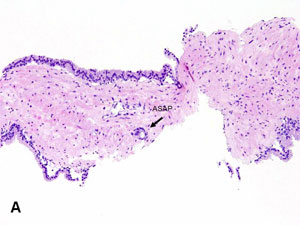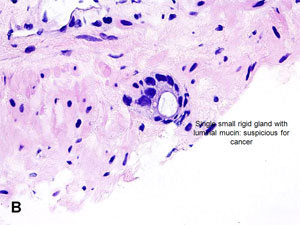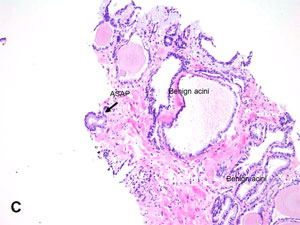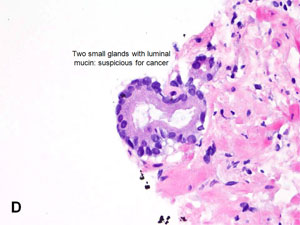Attention: Restrictions on use of AUA, AUAER, and UCF content in third party applications, including artificial intelligence technologies, such as large language models and generative AI.
You are prohibited from using or uploading content you accessed through this website into external applications, bots, software, or websites, including those using artificial intelligence technologies and infrastructure, including deep learning, machine learning and large language models and generative AI.
Atypical Small Acinar Proliferation (ASAP)
- Focus of atypical glands in needle biopsy that is quantitatively &/or qualitatively insufficient for definitive diagnosis or exclusion of prostate cancer.
- Not an entity, but a spectrum of different entities and include under sampled prostate cancer and its various benign mimics.
- Descriptive diagnosis to guide subsequent management.
- Repeat biopsy is indicated with ASAP diagnosis.
- Reasons for ASAP diagnosis by pathologists:
- Quantitative factor, such as too few atypical glands (<3) (image A), (image B), (image C),
& (image D). - Qualitative factors, such as insufficient architectural or cytologic features or no pathognomonic features of cancer.
- Compounding features such as obscuring inflammation, crushing artifacts and poor cytological detail.
- Quantitative factor, such as too few atypical glands (<3) (image A), (image B), (image C),
- Examples of benign mimic of cancers:
- Benign crowded glands and processes (atrophy, HGPIN, adenosis, sclerosing adenosis and basal cell hyperplasia).
- Non-prostatic structures within or near prostate (seminal vesicle or ejaculatory duct and Cowper's gland).
- Rare benign processes (mesonephric remnants, nephrogenic adenoma and verumontanum gland hyperplasia).
- ASAP diagnosis carries higher risk of finding prostate cancer in re-biopsy (40-50%; individual series vary between 17-70%).
- Subsequent prostate cancer may also be in contralateral side (up to 27%).
- Most prostate cancer on subsequent re-biopsy are Gleason score 6 (up to 80%).
- Some recommend qualifying ASAP, such as "suspicious" or "highly suspicious for cancer", to convey the risk in ASAP diagnosis and need for re-biopsy.
advertisement
advertisement




